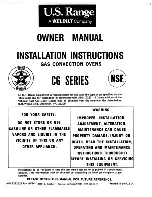
THE HEATING PRINCIPLE OF MICROWAVE
Microwave is one kind of radio wave whose wave length is very short, frequency is very high. Therefore, it is called ultrahigh
frequency electromagnetic wave. Microwave can heat food mainly result in the mutual affect of the food in the microwave field and
microwave field itself.
Under the affect of microwave field, the thermal effect mechanism produced from the mutual affect of the microwave and the food
includes two aspects: One is Dielectric loss of polar molecule, the other is conductive loss of ion.
Usually, food is constitute of organism (plant and animal).The organism is formed by all kinds of polar water molecule, polar
protein molecule, and all sorts of salt ion. The center of gravity of the positive and negative charge in the molecule is not coincide.
In normal condition, the molecule is in irregular order due to its thermal action, thus the food do not appear polarity (FIG.1-
1a).Under the action of outer electric field, the positive end of the polar molecule trend to the negative electric field, the negative
end of polar molecule trend to the positive electric field, and somewhat arrange in order through the direction of the electric
field(FIG.1-1c).This phenomenon usually be called “TORQUE POLARITY”. When the outer electric field apply for the opposite
polarity, the polar molecule then arrange an opposite direction order accordingly (FIG.1-1b).If the direction of the outer electric field
changed repeatedly, the polar molecule would repeatedly sway accordingly. During the swaying, it understands that the polar
molecule would produce heat due to somewhat similar friction among them.
When the electric field is applied for ultrahigh frequent microwave field from the outside, its direction would change tens billion
times per second, so do the molecule. This kind of molecule swaying producing similar frictional heat from the interference and
block of the action strength among the molecule, and changed to microscopic microwave heating. Microwave heating not only
concerned the nature of the matter itself, but also closely connected with the electric field strength and frequency. When the
frequency is low, the molecule swaying rate and the acute degree of the mutual friction among the molecule is low, and would
produce much heat. When the frequency is too high, as the swing of the polar molecule is with rotating inertia, it made the swing
do not in line with the changing rhythm of the electric field because of the friction drag, thus, actually lowed the polar molecule
swaying speed. The friction dragging degree is concerning about the magneto electric wave frequency, polar molecule shape, and
the matter’s sticky degree. To different matter’s molecule, there are different special frequency zone. Those ado
absorb microwave
energy from these zone are most capable to turn microwave energy to heat energy.
Apart from the above said action, there is another action which is electric ion under the action of microwave field, act fiercely
accompanied with the acceleration of electric field. The positive ion transfer to the negative polarity of the field while the negative
ion do opposite. Accompanying with the changing electric field, the electric ion changing accordingly. During the transferring, heat
produced with the crash among the ion. This kind of action take the main effect to those microwave heating of high salt molecule.
No matter it is the polar molecule swaying or the ion transferring, they both are turning the microwave energy which the heating
matter got from the microwave field to hear energy. From the analysis of theory, we can draw such a conclusion that the power
which a unit of volume matter absorbed from the microwave field as the following formula:
Pa=K·E· F·Er·tg
δ
Pa Stands for the power the heated matter absorbed from the microwave field.
K Stands for a constant
E Stand for microwave field strength
F Stands for the microwave frequency.
Er Stands for relative dielectric constant of the heated matter.
tg
δ
Stands for loss angle tangent of the heated matter
2-1






































